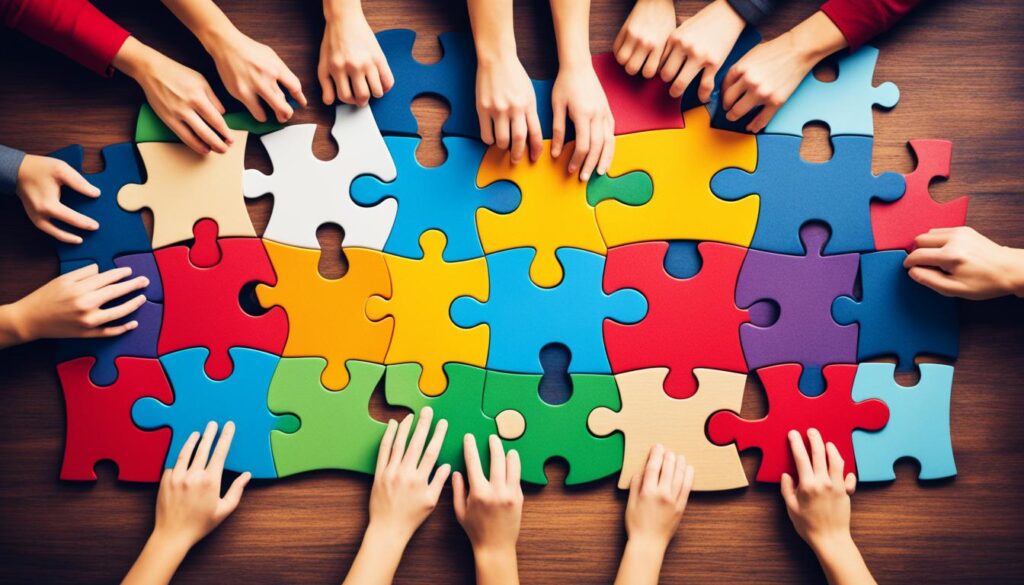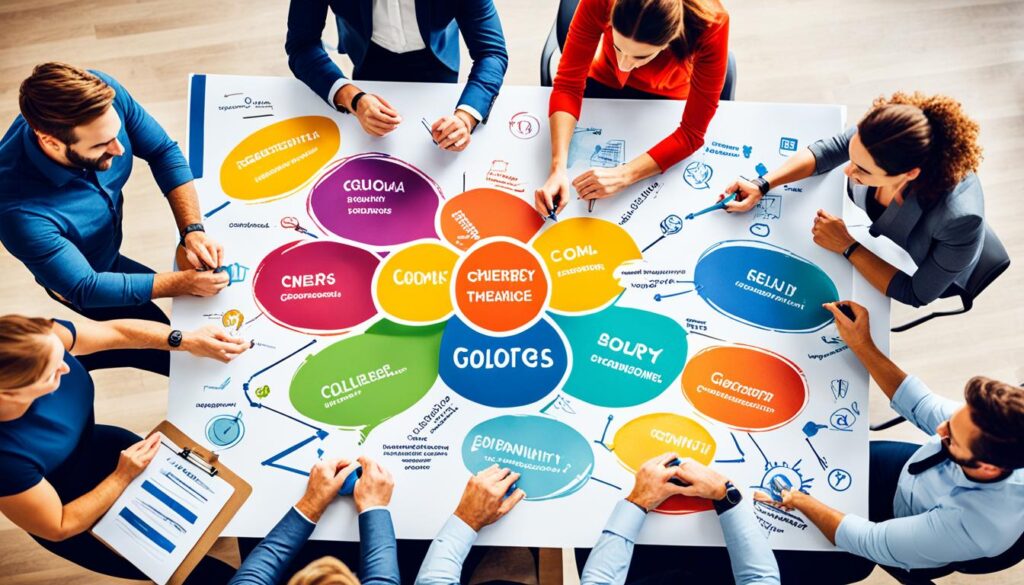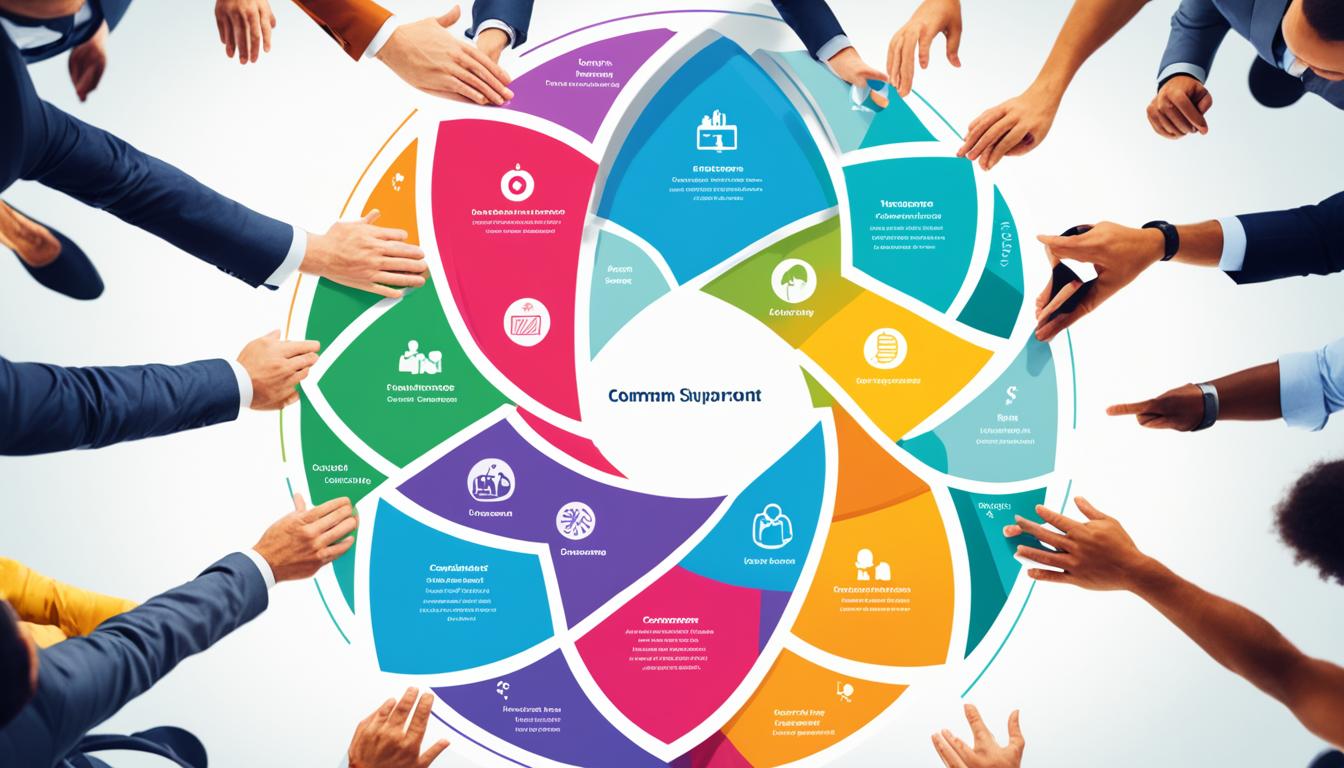According to the Kincentric Global Employee Engagement report, employee engagement has seen a decline, with engaged employees decreasing from 71% in 2020 to 62% in Q1 2022. To address this issue, organizations are seeking fast, efficient, and affordable solutions to boost employee engagement, including team effectiveness surveys. Today, we’ll explore the power of team effectiveness surveys as a tool for creating a high-performing culture where employees feel rewarded. By utilizing team effectiveness surveys, along with employee satisfaction surveys and employee performance reviews, even underperforming teams can achieve the desired results.
Key Takeaways
- An effective team dynamics survey enables organizations to optimize team performance and employee engagement.
- Teamwork evaluation provides insights into team communication, group dynamics, and overall performance.
- Team effectiveness surveys can help identify areas of improvement and facilitate team building.
- Utilizing survey tools and crafting relevant questions is essential for gathering actionable insights.
- Addressing challenges in team dynamics and building strong teams contributes to overall organizational success.
Crafting Effective Team Effectiveness Survey Questions
When it comes to assessing the effectiveness of your team, crafting the right survey questions can provide valuable insights into your team’s dynamics. These insights can help you identify areas for improvement and guide your efforts in building a more cohesive and high-performing team. Here are some key aspects that you should consider when formulating team effectiveness survey questions:
1. Team Goals and Objectives
Ask questions that gauge the clarity and alignment of team goals and objectives. This will help you understand if everyone is on the same page and if there is a shared understanding of what needs to be achieved.
2. Communication and Collaboration
Assess the effectiveness of communication within your team. Ask about the frequency and modes of communication used, and whether everyone feels comfortable expressing their opinions. Also, inquire about collaboration efforts and whether team members feel supported in working together towards common goals.
3. Roles and Responsibilities
Determine if team members have a clear understanding of their roles and responsibilities. Asking questions about task allocation and accountability can highlight any areas where role ambiguity may exist.
4. Decision-Making Processes
Explore how decisions are made within your team. Assess whether decisions are based on consensus or if there is a clear process in place. Also, inquire about the level of involvement team members have in the decision-making process.
5. Conflict Resolution
Understanding how conflicts are handled within your team is crucial for maintaining a positive and collaborative work environment. Assess the effectiveness of conflict resolution strategies and whether team members feel comfortable addressing conflicts openly.
6. Rewards and Recognition
Ask about the recognition and rewards system within your team. Determine if team members feel appreciated and if their contributions are acknowledged. This can provide insights into how motivated and satisfied team members are.
By incorporating these aspects into your team effectiveness survey questions, you can gain a deeper understanding of your team’s dynamics and identify areas for improvement. These questions can also be adapted for change management surveys and performance review surveys, allowing you to gather valuable feedback across various organizational processes and initiatives.
Conducting a Team Effectiveness Survey
To conduct a successful team effectiveness survey, it is essential to establish clear objectives and select the right survey tools. Begin by clearly defining your survey goals to ensure you gather the necessary insights to enhance team performance. Determine whether your survey will focus on overall team effectiveness or specific aspects such as communication, collaboration, or decision-making.
When it comes to survey tools, consider leveraging performance management software like Plai. With its user-friendly interface and robust features, Plai streamlines the survey process, making it more efficient and effective. It offers a range of survey templates and customization options, allowing you to tailor the survey to your specific needs and objectives.
Next, focus on crafting relevant and actionable questions that will provide you with valuable insights. Make sure your questions are specific, measurable, achievable, relevant, and time-bound (SMART). This ensures that the data you collect is actionable and contributes to meaningful improvements in team effectiveness.
Here’s an example of relevant and actionable questions for a team effectiveness survey:
- How well does the team align with its goals and objectives?
- Rate the team’s communication and collaboration on a scale of 1-10.
- How effectively does the team handle conflict and resolve issues?
- Are team members recognized and rewarded for their contributions?
Once your team effectiveness survey is ready, distribute it to your team members. Provide clear instructions on how to complete the survey and emphasize the importance of honest and constructive feedback. Assure your team that their responses are confidential and will be used to identify areas of improvement and drive positive change.
After receiving the survey responses, it’s time to analyze the results. Look for patterns, trends, and areas of strength and weakness. Use these insights to guide discussions with your team and develop targeted strategies to enhance team effectiveness.
Enhancing Team Effectiveness Based on Survey Insights
Once you have analyzed the survey results, you can enhance team effectiveness based on the insights you’ve gained. It’s crucial to identify both the strengths and areas for improvement within your team to optimize their performance. Here are some HR tips to help you foster team effectiveness:
- Align team goals with organizational objectives: Ensuring that your team’s objectives are aligned with the organization’s overall goals creates a sense of purpose and direction. This alignment helps team members understand how their individual contributions contribute to the larger picture.
- Facilitate open communication and collaboration: Encourage open communication channels within your team to promote a culture of transparency and active collaboration. This includes setting up regular team meetings, providing platforms for idea-sharing, and encouraging constructive feedback.
- Provide training and team development opportunities: Invest in the growth and development of your team members by offering training programs and other development opportunities. This helps improve their skills and capabilities, which in turn enhances team effectiveness.
- Promote a positive team culture and accountability: Foster a positive team culture that emphasizes accountability, mutual respect, and recognition for achievements. Encourage team members to take ownership of their work and recognize their contributions.
By implementing these HR tips, you can maximize team performance, enhance employee engagement, and improve overall company productivity. Remember, team effectiveness is not a one-time effort but an ongoing process that requires consistent attention and nurturing.

| Benefits of Enhancing Team Effectiveness | Actions to Take |
|---|---|
| Improved collaboration and communication | Facilitate regular team meetings Encourage open dialogue and idea-sharing Implement digital collaboration tools |
| Increased productivity and efficiency | Set clear goals and expectations Provide training and development opportunities Streamline workflows and processes |
| Enhanced problem-solving and innovation | Promote a culture of creativity and experimentation Encourage diverse perspectives Reward and recognize innovative ideas |
| Higher employee satisfaction and engagement | Create a positive and inclusive team culture Offer opportunities for growth and career development Recognize and appreciate team members’ contributions |
Understanding the Importance of Team Dynamics
Team dynamics play a crucial role in creating effective teams and improving workplace productivity. Positive group dynamics are defined by trust, collaboration, and a sense of collective ownership. Teams that communicate well, take ownership of their work, and collaborate effectively are more likely to achieve collective goals and deliver high-quality results. Good team dynamics not only impact the team members’ satisfaction at work but also affect customers, stakeholders, and the overall bottom line of the organization.
Cultivating Trust and Collaboration
In an environment built on trust, team members feel safe to express their ideas, share knowledge, and take risks. Trust is the foundation for effective communication and collaboration, allowing teams to work seamlessly to achieve shared objectives. When team members trust one another, they are more likely to support each other, resolve conflicts constructively, and share feedback openly.
Encouraging Ownership and Accountability
Teams with strong dynamics foster a sense of collective ownership. Each team member takes responsibility for their work and understands the impact of their contributions on the overall team’s success. This shared sense of ownership promotes accountability and motivates team members to perform at their best. When everyone feels a sense of responsibility, each individual is more committed to achieving team goals and delivering excellent results.
Driving Results through Effective Collaboration
Effective collaboration is the key to achieving collective goals. When teams collaborate successfully, they can leverage diverse perspectives, knowledge, and skills to solve complex problems and drive innovation. Collaboration fosters creativity, encourages cross-functional learning, and enhances decision-making processes. By working together, teams can overcome challenges, adapt to changing circumstances, and deliver superior outcomes.
Effective team dynamics are essential for creating a positive and productive workplace environment. When team members trust each other, collaborate effectively, and take ownership of their work, the entire organization benefits. Strong team dynamics contribute to increased employee satisfaction, improved customer experiences, and overall business success.

| Benefits of Strong Team Dynamics |
|---|
| Enhanced communication and information sharing |
| Improved problem-solving and decision-making |
| Increased productivity and efficiency |
| Greater employee engagement and job satisfaction |
| Enhanced innovation and creativity |
| Higher customer satisfaction and loyalty |
| Positive impact on organizational culture and reputation |
Managing Team Dynamics for Improved Performance
Managing team dynamics is crucial to ensure optimal performance. Several challenges can impact team effectiveness, including weak leadership, ineffective decision-making processes, lack of clear strategy, and destructive behavior. Addressing these challenges is essential to create a positive team environment and enhance overall team performance.
Weak Leadership: Coaching for Success
Weak leadership can disrupt team dynamics and hinder team performance. It is crucial to identify leaders who require additional support and training to enhance their leadership skills. By providing coaching and mentorship, organizations can help leaders become more effective in managing teams and fostering positive dynamics.
Decision-Making Processes: Balancing Authority and Collaboration
Effective decision-making processes strike a balance between top-down decisions and team involvement. It is important to empower team members to contribute their insights and ideas while ensuring that final decisions align with organizational goals and strategies. This inclusive approach fosters a sense of ownership and strengthens team dynamics.
Clear Goals and Strategies: Ensuring Alignment
A lack of clear goals and strategies can lead to confusion and conflicts within a team. It is crucial to communicate the organization’s goals and strategies effectively to team members. This clarity enables team members to align their efforts and work towards a common objective, resulting in improved team dynamics and performance.
Addressing Destructive Behavior: Creating a Positive Team Environment
Destructive behavior, such as negativity, conflict avoidance, or micromanagement, can harm team dynamics and diminish overall team performance. Organizations should promptly address such behavior, promote open communication, encourage collaboration, and foster a culture of respect and accountability. By creating a positive team environment, destructive behavior can be minimized, leading to enhanced team dynamics and performance.
Managing team dynamics requires proactive efforts to overcome challenges and foster a positive team environment. By addressing weak leadership, optimizing decision-making processes, communicating clear goals and strategies, and addressing destructive behavior, organizations can cultivate strong and cohesive teams that deliver optimal performance.
Building Strong Teams for Optimal Performance
Building strong teams is essential for achieving optimal performance in the workplace. It requires a combination of effective communication, workplace confidence, intentional team building, and information dissemination. By focusing on these key areas, organizations can cultivate a positive team culture and drive success.
Open communication plays a crucial role in fostering collaboration and enabling employees to give and receive feedback. When team members communicate openly and transparently, they can share ideas, address challenges, and work together towards common goals. Encouraging open communication empowers team members to express their thoughts, contribute valuable insights, and build trust within the team.
Building workplace confidence is another crucial aspect of building strong teams. When individuals feel confident in their abilities and supported by their colleagues, they are more likely to take risks, share ideas, and actively participate in team discussions. Building workplace confidence can be achieved through recognition of achievements, providing regular feedback, and creating a supportive and inclusive work environment.
Intentional team building activities are also essential for fostering a sense of camaraderie and trust among team members. This can be done through team-building exercises, workshops, and retreats that encourage collaboration, strengthen relationships, and enhance teamwork skills. These activities create opportunities for team members to bond, understand each other’s strengths, and develop a shared sense of purpose.
Ensuring information dissemination is smooth and efficient is vital for effective team performance. When team members have access to the right information at the right time, they can make informed decisions, collaborate effectively, and avoid unnecessary delays. Implementing communication channels, such as regular team meetings, project management tools, and knowledge-sharing platforms, helps ensure that information flows freely within the team.
Strong teams are built on a foundation of effective communication, workplace confidence, intentional team building, and information dissemination.
By prioritizing these elements, organizations can create a work environment that promotes teamwork, maximizes individual and collective potential, and drives optimal performance. Investing in building strong teams not only enhances team dynamics but also contributes to increased employee engagement, improved productivity, and overall organizational success.
Conclusion
Optimizing team dynamics is crucial for enhancing team performance and achieving organizational goals. By utilizing team effectiveness surveys, addressing challenges in team dynamics, and implementing strategies to build strong and cohesive teams, organizations can unlock their team’s potential and drive success. Additionally, fostering open communication and encouraging collaboration among team members can lead to innovative solutions and greater resilience in the face of challenges. One effective approach to identifying areas for improvement is to optimize teamwork with questionnaires that assess individual contributions, cooperation levels, and overall team satisfaction. By regularly gathering feedback through these tools, organizations can create a culture of continuous improvement and adaptability, ultimately leading to sustained high performance.
Creating a culture of open communication, workplace confidence, and collaboration contributes to improved team dynamics, employee engagement, and overall organizational performance. When team members feel comfortable expressing their ideas and concerns, trust and collaboration thrive, leading to effective teamwork and enhanced team performance.
By analyzing team effectiveness survey results, organizations gain valuable insights into their team’s strengths and areas for improvement. They can then take proactive measures to address any issues, such as providing training and development opportunities, promoting a positive team culture, and encouraging accountability. These actions not only optimize team dynamics but also foster a productive and rewarding work environment.
In conclusion, by prioritizing team dynamics, organizations lay the foundation for effective teams that drive success. Through a combination of team effectiveness surveys, strategic interventions, and a focus on open communication and collaboration, organizations can optimize team dynamics to maximize team performance and achieve their goals.
FAQ
What is a team dynamics survey?
A team dynamics survey is an assessment tool used to evaluate the dynamics and effectiveness of a team. It measures various aspects such as communication, collaboration, goal alignment, decision-making processes, conflict resolution, and recognition within the team.
Why is a team dynamics survey important?
A team dynamics survey is important because it provides valuable insights into how the team is functioning and what areas need improvement. It helps identify strengths and weaknesses, promotes open communication, and enables organizations to enhance team performance and achieve collective goals.
How can I craft effective team effectiveness survey questions?
To craft effective team effectiveness survey questions, cover aspects such as team goals, communication and collaboration, roles and responsibilities, decision-making processes, conflict resolution, and rewards and recognition. Make the questions specific, measurable, achievable, relevant, and time-bound to gather relevant and actionable insights.
What steps should I follow to conduct a team effectiveness survey?
When conducting a team effectiveness survey, define your survey goals, select the right survey tools such as performance management software, craft relevant questions, distribute the survey to your team, and analyze the results to gain insights into the team’s dynamics and performance.
How can I enhance team effectiveness based on survey insights?
To enhance team effectiveness based on survey insights, identify strengths and areas for improvement, align team goals with organizational objectives, promote open communication and collaboration, provide training and team development opportunities, and foster a positive team culture and accountability.
What is the importance of team dynamics in the workplace?
Team dynamics play a crucial role in the workplace as they contribute to creating effective teams and improving overall productivity. Positive group dynamics, characterized by trust, collaboration, and a sense of collective ownership, lead to higher employee satisfaction, better customer experiences, and improved organizational performance.
How can I manage team dynamics for improved performance?
To manage team dynamics for improved performance, address common challenges such as weak leadership, balance decision-making processes, communicate clear goals and strategies, and promptly address destructive behavior. Developing strong leadership skills and fostering a positive team environment are key to optimizing team dynamics.
What are the key factors in building strong teams for optimal performance?
Building strong teams for optimal performance involves effective communication, fostering workplace confidence, intentional team building activities, and ensuring information flows freely within the team. Open communication, workplace confidence, and trust among team members contribute to enhanced collaboration and efficiency.
How can optimizing team dynamics contribute to better team performance?
Optimizing team dynamics through effective team effectiveness surveys, addressing challenges, and implementing strategies to build strong and cohesive teams directly impacts team performance. It improves employee engagement, enhances collaboration, and aligns the team’s efforts with organizational goals, leading to improved overall performance.


